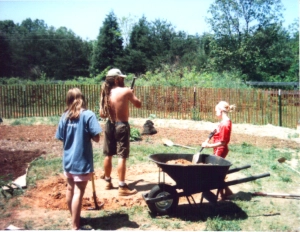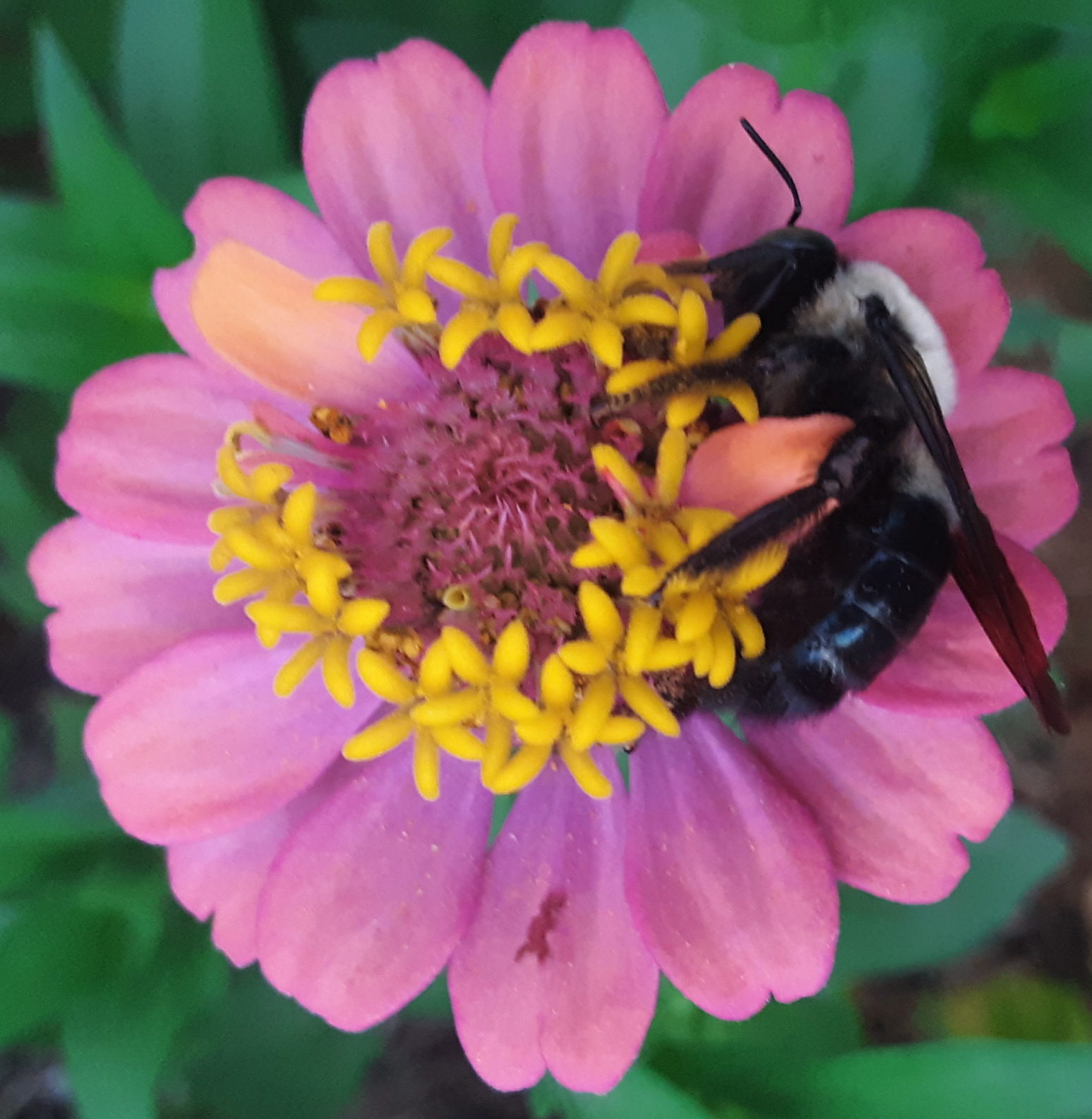
This year (Back in 2007, Ed.) Michael and the girls asked me what I wanted for Mother’s Day/ Since we’d fenced the front garden in, I could no longer see the big pond (which, if you read my post on Drought, has been pretty low anyhow), so I wanted a smaller, more aesthetically pleasing pond.
Our larger pond was built with a front-end loader, clay, lots of Bentonite, and a drainpipe that is connected to our downspouts to harvest all the rainwater off the roof. It has been an overall success in attracting frogs, birds, and bees. I wanted to add a habitat for these same creatures closer to the house so I could watch them from indoors on the couch in the winter, or from the hammock in the summer.
Therefore, on a beautiful, warm, and sunny May day, Michael, Jasmine, and Ajah set to work on digging a hole in our fabulous Virginia red clay. Sometimes, if you wet red clay and smooth it over with water, it will form a substance much like “slip” that potters use to attach items like pedestals and handles to their bowls and mugs. This “slip” substance can, in some lucky instances, be good at self-sealing clay and making easy ponds.
Well, I say “can”…For instance, our first pond building experience was so successful (in regard to sealing) that we foolishly decided to remove the island that was there, to enlarge it. Not only did this have the effect of making the pond bigger, but it broke its “seal.”
That is where Bentonite comes in handy. It is a material that has many applications, mainly for cosmetics and a as commercial feed binder. It is a mineral that is mined in Utah and is probably not very sustainably mined, being that the company is principally responsible for its excavation and distribution in Halliburton™.
Okay! Dilemma: our big pond had begun to leak, and we could either 1. Drain it, entirely killing all the frogs and fish living there so we could put down black plastic and hope that at least the frogs would come back but know plants, dogs, frost and any other sharp thing could negate our efforts 2. Use concrete that is ugly, heavy, and expensive, or 3. Use Bentonite. We finally reasoned that Option #3, at $4 per locally available 50-pound bag was our most cost-effective solution to close up any leaks and blend in with the pond environment.
To make a pond (large or small) with Bentonite, you have to dig a hole for however large you want or need, then wet the sides or bottom. Then, using a hand-rake or other agitating tool, apply the Bentonite in small handfuls, starting at the bottom, and work your way up. This way, the bottom should catch all errant Bentonite and with feet and hands, will be well-worked in by the time you are done. And, of course, it stands to reason, that the place you least want a leak is at the bottom of any vessel you want to hold water in.
So…after digging a 3′ deep hole, Michael and the kids (and me, because it is fun to play in the mud) began to sculpt two tiers of shelves for the water plants of different heights, and also for easier access for frogs, turtles, bees, and other visitors.
I do not know how many hours it took…I am sure it was more than we thought it would take (it always is), but in the late afternoon, the addition of Bentonite and water began to turn the hole into an exceptionally muddy spot. This is the part that seemed fun to me, for the day had been rather hot, but this is also the point at which Ajah opted out of the day-long project. (She is averse to mud) Since she’d put in more than her fair share of work with trowels, hand shovels, and the pick ax, no one was going to accuse her of slacking.
At this point, I am sure everyone was worried about what I’d request for Mother’s Day the following year. And my birthday always falls the week after Mother’s Day, no matter how many years I celebrate it. So, since I knew I could only get but so much mileage out of these two annual gift-giving occasions in May once the pond was full, I relieved everyone by announcing that a bridge and some rocks from the woods to edge the area would be it. No more gifts are necessary, but I did plan on spending my gift money from my mother and grandmothers on pond fish and water plants.
May was already shaping up to be hotter than I care for, so we had a lot of evaporation the first few weeks of the pond’s existence, which required more applications of Bentonite. This was not a huge problem, since we had several bags left over from the large project a few years before.
Finally, after obtaining some goldfish, and shubunkins (another fish for ornamental ponds that grows well in Virginia), the water hyacinth started to grow and shade the water. Michael used a few salvaged red oak boards from the barn that we had turned into our house. (An almost endless salvage project with just the wood that came out of the stall deconstruction).
The little Japanese-style bridge was simple but enabled us to sit in the middle of the pond to observe all the life in and around it. It was also perfect for the later sailing of origami boats when we hosted Rutsu, a Japanese exchange student. More importantly, it provided shade for the fish and helped slow evaporation just a little.
Still, due to the rainless summer, the pond required topping off from the rain barrel (or, occasionally the well) every couple of days.
By summer’s end, the little space not much bigger than a kiddie pool was ringed with sandstone and quartz rocks and filled with anachronous (a floating aquatic), multitudes of fish, thousands of tadpoles of several kinds, and growing water mint, arrow arum, water willow, water lily, and a few other yet-unidentified species of plants. We definitely spotted leopard frogs, bullfrogs, turtles, honey bees perched on delicate spongy water hyacinth, oddball mushrooms, and visiting birds (both resident and migratory) of all types.
We added a solar fountain at some point, which definitely had its shortcomings. Namely, it needs solar power from the sun, which does not happen if it’s cloudy, regardless of whether or not the pond needs filtering. The gurgling sounds it produced sans electricity is a welcome noise on the hottest of days, and it lets birds know that there is water nearby. I am sure that particular sound is exactly why we had so many neotropical birds like goldfinch and indigo buntings visit us that summer. And the dragonflies were countless!
Wherever I live, from now until I am gone, I hope if there is ever even the smallest place for a pond, I will have one. So far, luckily this has been true: whether in a child’s plastic pool, a whiskey barrel, a clay hole smoothed over with bentonite, a black-plastic lined sandy spot, or even a huge (ish) spot created with the best of intentions and perhaps a bit of over-zealous earth moving….there are so many ways to create a spot not just for the wildlife, but for mediation and nature-watching.
Because, even in the case of the unfortunately un-sealed pond, no matter how the pond looks to us, the creatures that show up have blessed us with their visitation, viewing a pond’s mere existence as the only invitation and welcome mat they need.


